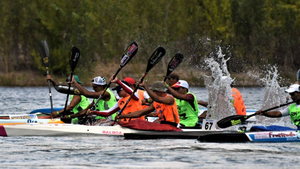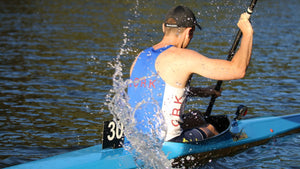Four considerations when transporting your surfski or kayak

Whether you drive a small car, a four wheel drive or a ute there are some simple ways to make your life easier and ensure that the surfskis and kayaks you’re transporting are safe. This blog isn’t a “best way to transport your surfski” but more of a guideline to think about when assessing your vehicle setup:
- Space your crossbars as far forward and as far back on your vehicle as possible
- Know the local overhang laws
- Know your vehicle height with roof racks
- Tie the bow of your surfski or kayak to your front bumper (if your boat is 7m+)
1. Space your crossbars as far forward and as far back on your vehicle as possible
Crossbars are mandatory. We recommend big named brands like Thule, Yakima or Rhino Racks as you don’t want the roof racks coming off their roof rail system still strapped securely to your kayak at 110km/hr on the highway (a story for another time).
You should try to space the crossbars as far forward and as far back on the vehicle as possible. This is to increase the support to your surfskis and kayaks. Think of the crossbar location as the pivot and the hull of your craft as a lever. The longer the distance from the crossbar the larger the lever and therefore the larger the force between the hull and the cradle. When driving against a strong crosswind or at high speeds this force is increased. So as paddlers who like stiff hulls to race fast we want to reduce this lever action as much as possible to prevent unnecessary pressure against our hull.
If you are limited by roof length the Wash Rider Y-Racks are perfect to expand your roof span and support your craft’s hull without buying a new vehicle.
I don’t have crossbars or a rail system for the roof racks?

Photo: Improvised crossbars for a rental car
If you don’t have crossbars or a rail system for roof racks there is not an ideal substitute for surfskis and kayaks. This situation can also occur if you are renting a vehicle which doesn’t have any roof racks or crossbars. In these cases, we recommend getting someone else to move the surfski for you.
2. Know the local overhang laws
Overhang, or Rear Overhang, is the term given by road authorities to the length limit measured from the centre of the rear wheel axle to the rear of a vehicle or any protruding load such as the end of your surfski. The Rear Projection is another term to describe the measurement from the rear of the vehicle to the rear of the end of a kayak. Both of these terms are shown in the diagram below:

The definition of the overhang differs slightly from state to state so check your local roads authority to identify how you can comply:
| Country/State | Rule with link to the road authority |
| Australia | |
|
Australian Capital Territory |
1.2m rear or forward maximum overhang |
| New South Wales |
1.2m maximum overhang Section 60 (3) |
| Northern Territory | |
| Queensland | 1.2m rear (requires a flag) and 1.2m forward maximum overhang |
| South Australia | 1.2m rear to 3.7m maximum rear overhang requires a flag. Light required at night. |
| Tasmania | 1.2m rear or forward maximum overhang |
| Victoria |
1.2m to 3.7m maximum rear overhang (requires a flag) and 1.2m maximum forward overhang |
| Western Australia | 1.2m rear projection measured from the end of the vehicle |
| New Zealand | 1m rear or forward maximum overhang |
| Singapore | |
| United Kingdom | |
| Canada (BC only) | 1.85m (6’8”) maximum read projection measured from the end of the vehicle |
| United States America |
California and Florida
4 feet from the rear of the vehicle requires a flag |
If you want to be visible and safe, protect your kayak or surfskis the WR Travel Sock.
3. Know your vehicle height with roof racks
Cradles are used to keep your craft secure and in place while driving. Without cradles your surfski or kayak can fishtail in the wind causing damage to your favourite toy or an unintended accident.
Things to look for with cradles are:
- Is the clearance of the garage or supermarket entry high enough for your vehicle plus cradles? Or can you remove the cradles easily before entering?
- Some rubber leaves black marks on hulls. The Wash Rider Y Racks are made with neoprene covered rubber to cushion and provide the ability to slide the kayak onto the racks without leaving black marks.
Craft position on the cradles
Refer to your local overhang limits to work out where best to place your surfski or kayak on the cradles. We recommend starting by placing your craft on the cradles so the centre of the surfski or kayak is at an equal distance from each cradle. Then due to the position of most cars roof racks being towards the rear of most cars, the craft will need to be moved forward to reduce the rear overhang.
Securing your kayak to the roof racks
Once in the cradles you need to secure your surfskis and kayaks so they don’t fly. A common method is to use cam straps but in completing research for the Wash Rider Y Racks we’ve found that the best way was to incorporate stainless steel retractable ratchets to get the right pressure to secure the craft and keep the straps all-in-one with the racks as shown in the video below.
4. Tie the bow of your surfski or kayak to your front bumper (if your boat is 7m+)
In addition to roof racks, securing the front of your surfski to the front of your vehicle is a good idea when traveling especially when in high winds or when your moving a K2 (6.5m+) or double surfski (7m+) or sea kayak. The extra length acts as a lever which puts more pressure on the cradle area of the hull. By tying the front or the extra length to the ends of your car you’ll reduce the force against the cradles and the flex in the hull from being caught by the wind or high-speed driving. Not all cars can easily secure the front and back of the surfski or kayak to the bumper bars but usually, there is a towing hook under the front and back bumper bar. This can be attached to a cam strap or rope which is then slung around the excess length in the craft. Don’t tighten too much that the hull bends down against the cradles.
Have any other queries or questions? Make a comment and we'll do our best to answer it.
- Kieran Babich







Comments 6
Kieran (Wash Rider)
Hi Rich, we’ve just checked our email again since we contacted several of the state roads authorities months back. We haven’t heard anything from them. I’ll reignite it with each and see where we get to.
Rich
It been a while – is there any update available on the below post please ?
“Hey Rod, we’ve heard you and other paddlers on this one and have reached out to a few of the states where the regulation isn’t clear. At this time though our understanding is that the overhang applies to light vehicles rather than rear projection. We’ll reach out once we have the confirmations from the state bodies.”
Kieran (Wash Rider)
Hey Rod, we’ve heard you and other paddlers on this one and have reached out to a few of the states where the regulation isn’t clear. At this time though our understanding is that the overhang applies to light vehicles rather than rear projection. We’ll reach out once we have the confirmations from the state bodies.
Rod
It looks like the table confuses rear overhang and rear projection. For example the nsw Regs allow for 1.2m projection (ie 1.2m past the back of the car) but this is listed on your table as 1.2m rear overhang (1.2m past the rear axle) which is much less.
If these were all checked and corrected it would be a great resource to share around, especially for paddlers driving across state borders.
Cheers Rod
Kieran (Wash Rider)
Hey Jai, from the emails and messages we’ve received it’s looking like there are many paddlers confused by us. We’ll update the wording as we learn more from the transport authorities we’ve contacted for further clarification.
Jai
This is a bit weird to apply rear overhang to a station wagon and the rear cabin size will dramatically reduce the projection
Your take on this?